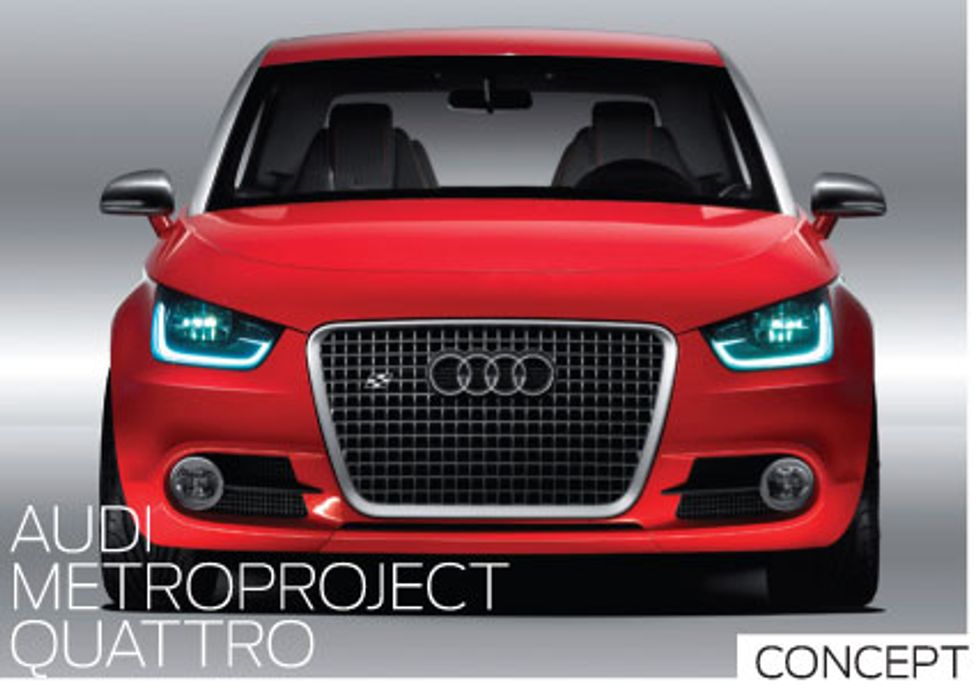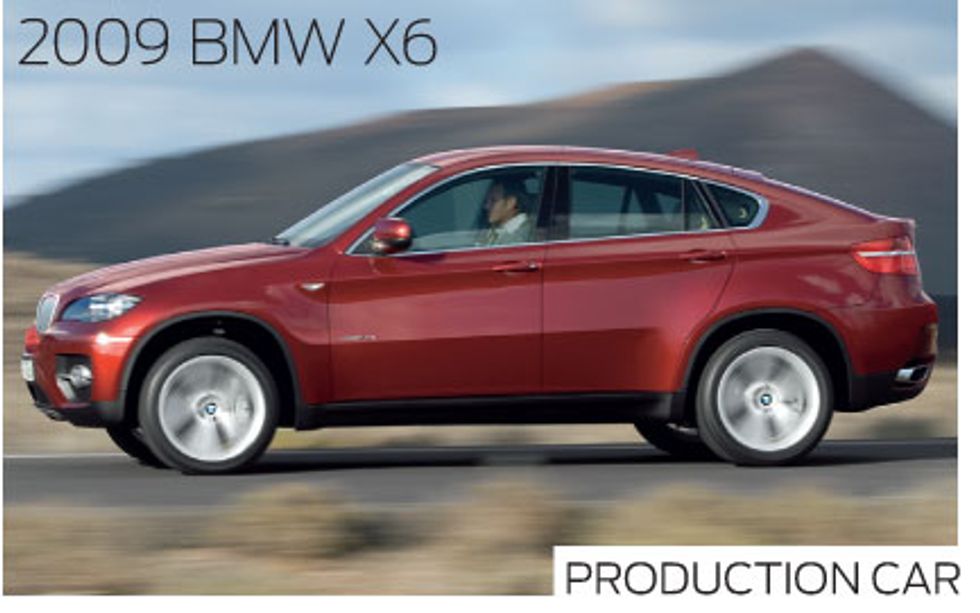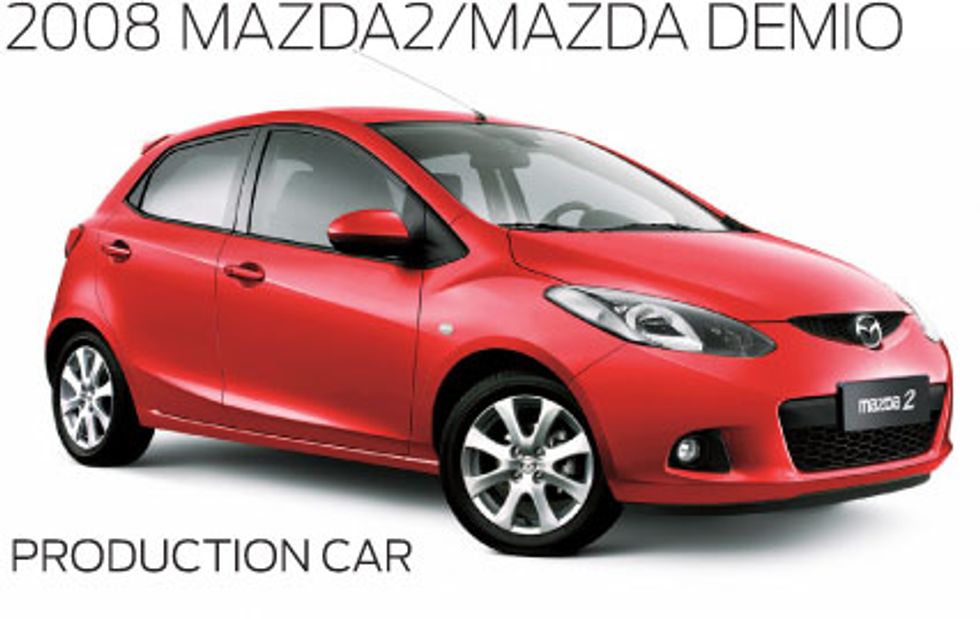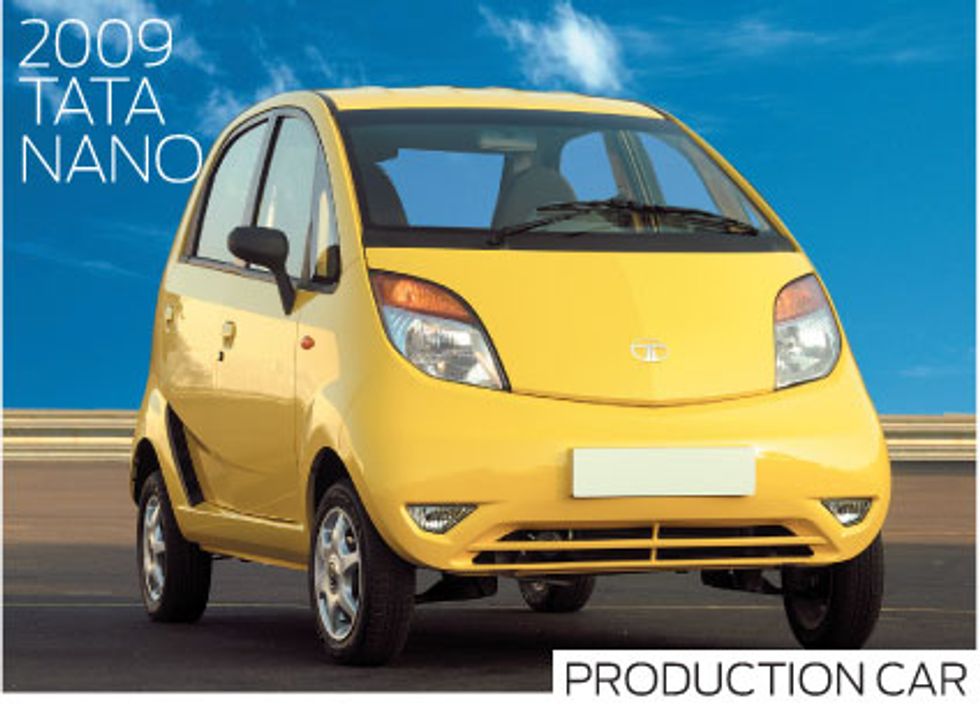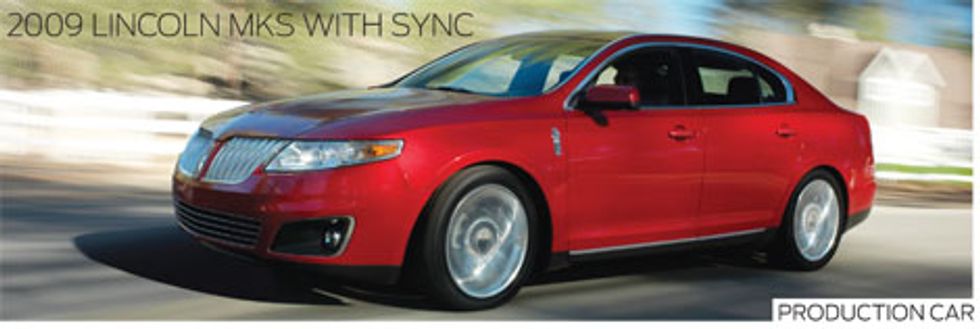Top 10 Tech Cars of 2008
It's the environment, stupid
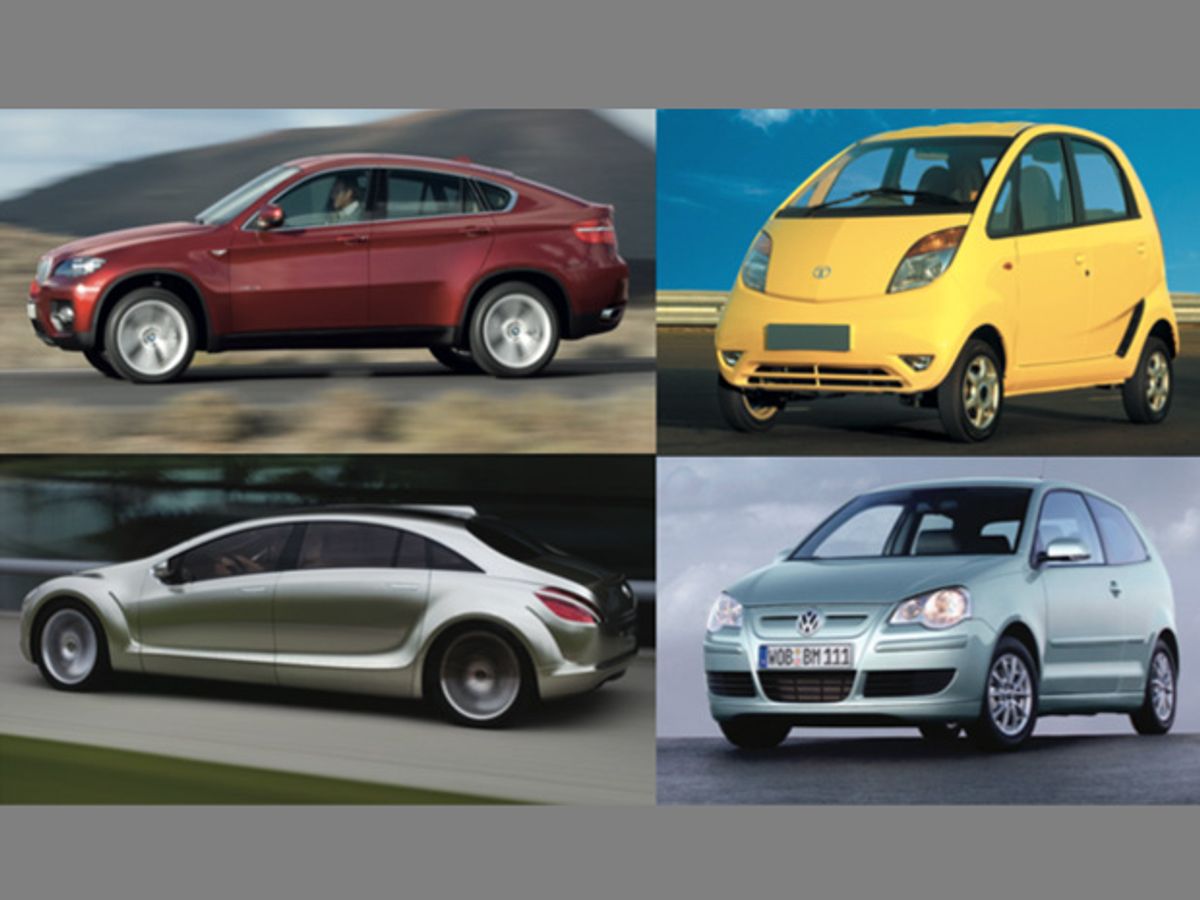
When a sexy silver Ferrari F430 Spider has “Bio Fuel” emblazoned on the doors in bright green, you know the world has changed. Yet that was the sight at a major auto show early this year. As one industry commentator put it, “Green is the new black.”
Consider that Europe is debating not whether to cut carbon emissions from vehicles but simply when to do it and by how much. The average new car on Europe’s roads now emits roughly 160 grams of carbon dioxide per kilometer; the European Commission proposed last year to lower that to 130 g/km by 2012. But Europe’s carmakers seem likely to have missed a voluntary 2008 target of 140 g/km.
This issue has pitted French and Italian carmakers—who specialize in small, fuel-efficient cars—against German manufacturers, who could see many of their luxury and sports-car products become problematic. Now a staggered set of weight-based limits may be instituted, and the deadline may be pushed all the way to 2015.
Carbon emissions are becoming a standard automotive benchmark in Europe and parts of Asia, but North American car buyers remain almost entirely unaware of them. To reflect the global discussion, IEEE Spectrum has included whatever numbers on vehicle CO2 emissions we could obtain from the manufacturers.
Many of this year’s innovations center on combustion-engine technology—Ford’s EcoBoost turbocharged gasoline direct-injection engines, Mazda’s tiny Miller-cycle engine, BMW’s centrally mounted twin turbochargers. Then there’s the diesel engine, which appears set for a revival following the fuel-economy regulations enacted late last year in the United States. Both European and Japanese carmakers are preparing to launch diesels in North America over the next two to five years. Even though the engine requires elaborate and costly emissions controls—like the Mercedes-Benz Bluetec system—to trap the great number of fine particulates diesels emit, their lower fuel usage and CO2 emissions are unquestioned.
Will U.S. buyers go for diesels? No one knows. It may be the industry’s biggest open question.
The plug-in hybrid electric vehicle is another puzzle. General Motors is expressing quiet confidence that lithium-ion batteries will clear the various hurdles needed for a late-2010 launch of its Chevrolet Volt extended-range electric car, projected to have a 64-km range on electric power alone. A plug-in version of GM’s Saturn Vue Two-Mode Hybrid sport utility is due on roughly the same schedule, with a 16-km range. Toyota, meanwhile, abruptly changed its tune on plug-ins, launching a test fleet of Priuses converted to plug-in operation. It’s a conversion that private customers have been ordering, one car at a time, at small garages across the United States and in other countries.
The trend extends even to China, where horrific air pollution and increasing dependence on imported oil threaten to muffle the country’s economic boom. BYD Co., a Chinese battery company that claims to supply two-thirds of the world’s nickel-cadmium batteries and 30 percent of its lithium-ion mobile-phone batteries, started making cars in 2002. In January it demonstrated a plug-in hybrid sedan with a claimed electric range of 96 km, which the company said would be offered for sale in small numbers—in China only—by the end of this year. That said, fewer than 200 plug-in hybrid cars are on the world’s roads.
Finally, the industry is doing something about the weight of its products. Ford’s EcoBoost V6 engine, for example, provides the power and torque of a much larger V8 with better fuel economy, lower emissions, and less weight. Even so, a fully accessorized EcoBoost weighs about half as much as an entire Tata Nano, from India, which at US $2500 is cheaper than the options packages for many cars. That low price, and planned production in the millions, make the Nano easily the most important launch of the year. It is feared by the global auto industry and eagerly awaited by millions of Indian families, who now often travel in groups of four or five on a single scooter.
Ferrari performance at one-third the price
In some ways, it’s the antithesis of advanced sports-car design. It’s got an engine up front, with only two valves per cylinder, and those valves are opened and closed with pushrods, just as they were in engines a lifetime ago. Parts of the body are made of fiberglass, a distinctly old-fashioned material compared with the aluminum, magnesium, and carbon fiber used by the Corvette’s competitors.
And yet, the Chevrolet Corvette ZR1 does one thing very well: it carries two people as fast as possible, whether on straight or winding roads. The Corvette is the only U.S. volume car with ceramic brake rotors and a polycarbonate window in its hood that gives a peek at the intercooler. Chevrolet’s goals are simple: maximize power, minimize mass.
Developed under the code name Blue Devil, the ZR1 is built around a 6.2-liter aluminum V8 developing 462 kilowatts (620 horsepower) of power and 807 newton meters (595 foot-pounds) of torque. The aluminum block has the dimensions of the classic Chevrolet small-block V8, but this one is hand-built at a special engine shop with processes used only for racing engines. For instance, a deck plate is installed on the aluminum block, to simulate the pressure and minute dimensional differences created by the cylinder heads, before the cast-iron cylinder liners are pressed into it.
A Roots-type supercharger crams air into the engine via an intercooler, providing a denser dose of oxygen that’s nevertheless cooled down enough to fend off power-sapping premature combustion. Like most supercharged engines, it can deliver close to peak power over a wide range of engine speeds, from about 2500 revolutions per minute to 6600 rpm.
To handle all that power, the clutch uses a pair of smaller discs rather than the single plate of other Corvettes. This spreads the torque over a greater area and reduces inertia by 25 percent, letting the engine spool up or down more quickly. As with the highest-performance German cars, the ZR1’s brake rotors are made of ceramic silicon carbide reinforced with carbon fiber, which is less susceptible to the friction-induced changes that can cause brake power to fade temporarily after repeated high-speed braking.
Ride control on the ZR1 employs a suspension of magnetic particles in a fluid instead of mechanical shocks. The viscosity of the fluid changes in response to a magnetic field, which varies every millisecond in response to inputs from sensors providing data on speed, suspension, and road surface conditions.
The roof, hood, front fenders, rocker panels, and some smaller parts are made of carbon fiber instead of steel, and the weight saved offsets the heavier engine. The car weighs just 1520 kilograms (3351 pounds).
Chevrolet hadn’t released performance data by press time, but it said the ZR1 is expected to be the first production Corvette to exceed 320 kilometers per hour (200 miles per hour). It’s rumored that the car accelerates from 0 to 100 km/h (62 mph) in less than 3.5 seconds. The factory did confirm that the cornering grip is more than 1 g—enough to make you feel twice your weight in a perfectly banked curve. That’s among the highest g-forces of any production vehicle today.
At roughly US $100 000, the ZR1 bests cars costing two to four times as much. It’s the only U.S. vehicle that routinely competes successfully in the fabled 24 Heures du Mans race, better known as Le Mans—heady company indeed for a car from Kentucky.
• Power Plant: 110-kW 1.4-L turbocharged fuel-stratified injection engine; 30-kW electric motor • Transmission: S-tronic 6-speed Direct-Shift Gearbox, a pairing of two manual gearboxes • Claimed Fuel Efficiency: 4.9 L/100 km (48 mpg) in mixed-mode operation • Claimed CO2 Emissions: 112 g/km • More: Minus the hybrid, the Metroproject is likely a preview of Audi’s upcoming A2 subcompact.
A plug-in hybrid with its own mobile phone—and then some
This small and handsome Audi concept contains a surprise that wowed the gadget lovers at the 2007 Tokyo Motor Show: the removable “Audi mobile device,” which combines elements of the iPhone, a key fob, a media player, and a wireless security monitor.
You can make phone calls, view maps, listen to music, and watch videos on the bright red device, but you can also unlock the car, ensure you locked the doors, start the engine remotely (to warm it up on a cold day), and view what’s going on inside the car via an interior camera (in case the kids—or thieves—take it for a spin).
The Metroproject is one of several European concept cars this year equipped with a plugâ¿¿in hybrid-electric power train. Here, a lithium-ion battery pack provides an electric range of up to 100 kilometers (62 miles) at a top speed of more than 100 km/h. The 1.4-liter engine cuts in when the battery’s charge falls below 20 percent of its maximum.
Multihole injectors deliver fuel directly into the combustion chambers, and the turbo has been tuned to deliver power across the range of engine speeds. This arrangement minimizes the “turbo lag” that usually comes when the turbocharger spools up to a speed that’s fast enough to compress the air it delivers to the intake manifold. Audi claims that 80 percent of the engine’s peak torque is available from 1250 revolutions per minute.
The Metroproject’s Quattro all-wheel drive is delivered by a combination of engine and motor. The combustion engine, generating 240 newton meters (177 foot-pounds) of torque, drives the front wheels; a 30-kilowatt (40 horsepower) electric motor, which adds 200 Nm (147 ft-lb), powers the rear wheels.
Audi says the hybrid system provides 15 percent better fuel efficiency than you’d get by using the engine alone. With a top speed of 200 km/h (124 mph) and acceleration from 0 to 100 km/h (0 to 62 mph) in 7.8 seconds, the Metroproject is something of a “performance hybrid”—a concept that so far hasn’t proven popular in the United States, currently the largest market for hybrids of all sorts.
Drivers can choose between “efficiency” and “dynamic” configurations, which vary the control settings for throttle mapping, shift points, suspension stiffness, and other systems. Such variable personalities within the same car are another increasingly common feature in concepts (and a few production vehicles). They offer the driver a choice among profiles that combine different settings for the car’s various electronic control systems, usually maximizing fuel economy at one extreme and performance at the other.
A new type of engine in a radical reinterpretation of the big benz
Low and sleek, the styling of this highly conceptual study for a future full-size S-Class Mercedes-Benz is almost as striking as its tiny power plant: a 1.8-liter four-cylinder engine that combines the advantages of diesel and spark-ignition engines while avoiding the disadvantages peculiar to each.
First let’s review: spark-ignition engines use a spark plug to ignite a vapor of gasoline and air, compressed at a ratio of perhaps 10:1, so that the burn starts at one end of the combustion chamber and propagates to the other. Diesel engines compress the vapor to a much higher ratio—say, 25:1—so that it combusts spontaneously, beginning at the edges and propagating inward.
The Mercedes design gets the best of both worlds by exploiting a formerly wasted product: the exhaust gas left over from the previous combustion cycle. That gas prewarms the incoming fuel-air mixture so that it needs less compression to reach ignition temperature. There are two such injections per cycle, and both require a very fine control of temperature and pressure.
When the piston reaches the top of its compression stroke, at a ratio closer to a spark-ignition engine’s than a diesel’s, the ignition begins spontaneously, not only at the edges of the chamber but at many points throughout. The result is a complete, efficient burn at temperatures too low for the formation of nitrous oxides—the diesel engine’s Achilles’ heel. Although the new engine’s combustion produces less torque than you’d get from either a diesel or a spark-ignition engine, you’ll never notice the lack under partial load—when you’re at cruising speed, for instance. When you do need that torque, the engine operates just like its spark-ignition counterpart.
This design is known in the industry as homogeneous charge-compression ignition (HCCI), although Mercedes calls it DiesOtto, in homage to Rudolph Diesel and Nikolaus Otto, who invented the diesel and spark-ignition engines, respectively, in the 19th century. For many years the idea was shelved because practical engine controls were lacking. Relentless improvement in processing power, as quantified by Moore’s Law, has now solved that problem.
The F700’s engine includes two turbos—a small one for lower engine speeds, a large one for higher speeds—plus additional torque on launch from an electric motor integrated into the transmission. There’s also a modification to the crankshaft, which the manufacturer doesn’t spell out, that makes it possible to vary the engine’s compression ratio. (Other manufacturers experimenting with HCCI engines, notably General Motors, make no such modification.)
The results are fairly startling. The carmaker claims 190 kilowatts (255 horsepower) at maximum load from a mere 1.8-liter four-cylinder engine while using only 5.3 liters per 100 kilometers (44 miles per gallon) at cruising speeds—in a vehicle weighing 1700 kilograms (3748 pounds).
The drawbacks? First, each cylinder needs its own pressure transducer so that the engine controller can fine-tune the combustion cycle, and those transducers are still very expensive. Second, the torrent of data from those transducers and other sensors makes the logic in the engine controller far more challenging.
In time, HCCI engines might be cheaper than diesels to build because they don’t need the structural reinforcement that makes high-compression diesels heavier than conventional engines of equal power. They can also dispense with the complex emissions-control systems (such as Mercedes’s Bluetec) that diesels need in order to meet California standards.
The F700 concept has a slew of other fascinating features, from rear-hinged rear doors to its Pre-Scan hydraulic active suspension, which continuously processes optical data from the road ahead to change its settings proactively.
The industry expects HCCI engines to make it into production sometime between 2015 and 2020. This concept car could be the basis of perhaps the least conservative model ever seen in the S-Class, the most prestigious Mercedes line. Even in a world of rising oil prices and legislated limits on carbon emissions, this daring vehicle shows that there’s life left in the combustion engine.
• Power Plant: 298-kW (400 hp) 4.4-L twin-turbocharged direct-injection V8 • Transmission: 6-speed automatic; steering wheel–mounted paddle shifters • Claimed Fuel Efficiency : Information not available • Claimed CO2 Emissions: Information not available • More: The X6 lineup is likely to include both hybrid-electric and 197-kW 3.0-L six-cylinder diesel variants in the near future; the BMW X5 sport utility, to which it is closely related, will offer that diesel in 2009.
Meet FlexRay, the new high-speed automotive data bus
Remember how magical the first antilock brakes seemed, back in the 1980s, when they stopped your car smoothly with half the wheels on ice and the other half on dry pavement? Those systems processed sensor data a few times per second, feeding the information to a dedicated brake controller. Compare that with today’s cars, which process data from scores of in-car sensors—and even include external factors, like vehicle proximity—and instantly crunch the numbers with up to a dozen control systems, integrated by a vehicle controller. Now consider tomorrow’s car, which will be nothing less than a local area network on wheels. For it, the relevant metric will be bandwidth.
The BMW X6 is the first production vehicle to build in the next order of bandwidth, using a scheme called FlexRay, a high-speed data bus developed by a consortium of carmakers and component suppliers. FlexRay offers two communication channels, each with a data rate of 10 megabits per second, a 10- to 40-fold increase over current in-car communications protocols, depending on how the system is implemented.
FlexRay ferries data among the components of adaptive drive, a vastly enhanced descendant of yesteryear’s automatic braking. Instead of just detecting a wheel’s traction, adaptive drive uses a central controller to interpret sensor data on speed, steering angle, longitudinal and lateral acceleration, body and wheel velocity, damper position, and other criteria. The system controls body roll and adjusts the dampers to keep the vehicle stable during virtually any maneuver.
The all-wheel-drive X6—which BMW calls a sports activity coupe—doesn’t stint on horsepower, either. It’s offered with a 4.4-liter aluminum V8 that puts its twin turbochargers in a novel position. They nestle between the V-shaped banks of the engine instead of hanging off the exhaust manifolds outside the V. The scheme works because BMW has switched the position of the manifolds and the air intakes, so that the exhaust gases flow inside the V-formation and therefore need to travel just a few centimeters to reach the vanes of the charger’s turbine. This way, the exhaust can spin the turbine up with less delay between stamping on the accelerator and getting that extra turbo goodness.
To make that process possible, the company developed turbochargers from materials that could operate in the hotter environment between the banks, a virtual oven that continuously bakes the turbo system at hundreds of degrees.
Another innovation is what BMW calls Dynamic Performance Control, or DPC—one entry in an alphabet soup of electronic traction, suspension, and engine control systems. The DPC controls the effects of a rear differential that includes two planetary gear sets, each containing a central gear (the “sun”) spun by engine torque. This sun is surrounded by planet gears that are in turn housed in a ring gear that drives the individual wheel through two clutch packs, allowing the controller to reduce or multiply torque to each rear wheel individually to enhance steering, stability, and traction.
Possibly the world’s most practical ultrahigh-performance car
The Nissan GT-R has always combined pulse-quickening performance with technological innovation. It offered all-wheel drive, four-wheel steering, and twin turbochargers many years before these features could be had in lesser vehicles. This, the fifth generation since the GT-R’s inception in 1969, is the first to be offered globally, including in the very visible U.S. market.
The car’s designers have always eschewed the V8 or V12 engines used in many of its two-seater rivals, instead using twin turbochargers to squeeze out all the power it needs from six cylinders. This year, though, they’re set in “V” formation, a switch from the prior model’s in-line six. The resulting 358 kilowatts (480 horsepower) of power and 583 newton meters (437 foot-pounds) of torque are even more impressive, considering that the car also qualifies for the ultralow-emissions vehicle rating of the U.S. Environmental Protection Agency.
The engine sits aft of the frontâ¿¿wheel centers, and it drives not a conventional attached gearbox but a rear transaxle containing a dual-clutch transmission and transfer case, which then splits power among the four wheels. The dual-clutch transmission assigns separate clutches for the odd and even gears, letting it preselect the next highest and lowest gear for almost instantaneous shifts.
That unusual arrangement lets Nissan achieve a weight distribution of 53 percent front, 47 percent rear—close to the 50-50 ideal. The all-wheel drive system offers a torque split ranging smoothly from 100 percent rear to 50/50 front-rear. The driver can choose among three settings—Normal, Comfort, or R, for ultimate handling—for several systems, including engine and transmission mappings and suspension control. How often a GT-R driver would select Comfort is moot.
Nissan says the instrument panel display is ”video game–inspired,” not an unalloyed gain for those who prefer drivers to focus on driving. As is fitting in a performance car, the panel shows acceleration, brake-pedal pressure, and steering angle; it even records large blocks of operating data, like the black box on a jetliner. When not showing such data, the panel also controls the navigation system, audio equipment, and mobile phone system.
• Power Plant: 66-kW (89 hp) 1.3-L Miller-cycle 16-valve four-cylinder • Transmission: Continuously variable transmission (CVT) • Claimed Fuel Efficiency: 4.3 L/100 km (55 mpg) on Japanese combined cycle • Claimed CO2 Emissions: 129 g/km • More: The “platform” or understructure will be the basis for a new Ford Fiesta in Europe, and Ford is considering selling it in the United States.
Newer, better equipped…and lighter
The latest Mazda2 (called the Demio in some markets) has gotten more capacious, more capable, better equipped, and at 990 kilograms, 100 kg lighter—all at the same time. With one model that offers both Mazda’s Miller-cycle engine, this time in 1.3-liter form, and the company’s first continuously variable transmission, it begins to look like a very advanced small car indeed.
The Miller cycle increases the efficiency of a four-cycle “Otto” engine with a fifth cycle, by dividing the compression stroke into two parts. In the first 20 to 30 percent of the stroke, the intake valves are held open so the piston can push some of the fuel-air mixture out the door, as it were. This leakage eases the load at a point when the piston’s leverage is at its worst. Then the standard procedure is to push the mixture back in again using a supercharger—a compressor driven by the crankshaft—until the piston reaches a mechanically more advantageous position in which to finish the compression. Because this exploitation of mechanical advantage saves more energy than the supercharger consumes, overall efficiency improves.
Mazda, however, dispenses with the supercharger, instead minimizing the fuel-air leakage with variable valve timing and clever tweaks to the combustion chamber. The company has also minimized the lower power and torque of the Miller cycle. Compared with the conventional version of the same engine, power is down just 1 kilowatt and torque declines just slightly, to 120 from 124 newton meters (89 foot-pounds).
Mazda says the 1.3-L Miller-cycle model uses just 4.3 liters per 100 kilometers (55 miles per gallon) in the Japanese fuel-economy cycle and cuts emissions to 75 percent below the old limits that took effect in 2005. (It is also offered with a 1.5-L engine, and a 1.4-L diesel in Europe.) The Mazda2 is not sold in the United States.
Ford is a part owner of Mazda, and so the car’s design is an early indicator of one element in Ford’s “blueprint for sustainability” to improve energy efficiency: make it lighter. Mazda slimmed the car down even while meeting new crash-safety standards and adding hardware, including entertainment gear and navigation systems. It did that by using ultrahigh-strength tensile steel and stronger welds to reduce weight while improving rigidity. It also improved the coefficient of drag to 0.32, respectable for a car just 3.9 meters long but 1.5 meters high and 1.7 meters wide.
A stunning stereo, in a breathtaking design
It’s a striking, elegant departure, the first Jaguar to break away from traditional styling cues in 40 years. It may be the most important car in Jaguar’s history, the one that must prove there’s a future for the storied marque after Ford sells it to Tata Motors, the Indian maker of the lowest-priced car in the world (see “2009 Tata Nano”).
Of course, you wouldn’t be reading this if the XF were mere eye candy—its tech credentials are solid too. The interior fittings emerge from hiding only when needed. When a driver gets in, the car senses the proximity of the electronic key card and its “start” button pulses red. Pressing the button causes the rotary gear selector to rise out of the console and into the driver’s hand. On first demonstration, you can almost hear Q of the James Bond films saying, “Really, 007, just once I would like to get a car back in one piece!”
Similarly, passengers can’t see the dashboard vents until they wave their hands toward them, whereupon sensors trigger motors that rotate the vents into place. Overhead lights and the glove-compartment lid operate the same way. The goal is to reduce cabin clutter and increase the sense of soothing calm for all occupants; soft phosphor blue “halo” lighting heightens the mood.
The wizards of Bowers & Wilkins, an audiophile favorite in Worthing, England, planned the acoustics of this high-speed concert hall. They worked alongside Jaguar’s engineers, putting 14 custom-designed speakers in the optimal places. The larger speakers have distinctive yellow Kevlar cones, for better linear response and reduced distortion; the four tweeters carry aluminum transducer domes that cut the weight of the one moving part, extending treble response an octave above that of standard designs.
The 440-watt surround-sound system uses Dolby logic in the remote amplifier, with the de rigueur inputs for personal MP3 players and USB storage devices, of course, all controlled through the car’s touch-screen display. The system continuously monitors interior noise, adjusting its equalization to compensate.
Not all the tech goes toward creature comforts. There’s a system that uses radar to alert the driver to nearby vehicles he or she can’t see. The optional adaptive cruise control—quickly becoming a must-have on luxury cars—keeps the car a safe distance behind the one that’s just ahead. And Jaguar also offers an automatic speed limiter—handy for those already saddled with a few speeding tickets.
• Power Plant: 24-kW (32 hp) 623-cc aluminum two-cylinder • Transmission: Continuously variable transmission (CVT) • Claimed Fuel Efficiency: 4.7 L/100 km (50 mpg) • Claimed CO2 Emissions: 120 g/km • More: Tata plans to sell an upscale version in Europe, possibly for as little as one-third the price of the cheapest new car today. European makers are apprehensive.
Re-creating the people’s car
In January, some 100 years after Henry Ford launched his Model T—the first car expressly designed for people of modest means—Ratan Tata did it all over again. The chairman of India’s Tata Motors drove a white Nano onto the stage at the Auto Expo in New Delhi, making good on the promise of a 1-lakh car (100 000 rupees, or about US $2500).
Like predecessor “people’s cars” that put whole nations on wheels—the Model T, Germany’s Volkswagen Beetle, France’s Citroën 2CV, Italy’s Fiat 500—it uses technology only where it’s needed.
The basic model forgoes air-conditioning, power steering, central locking, electric windows, a radio, a passenger-side mirror, even sun visors and a second windshield wiper. Its 623-cubic-centimeter two-cylinder engine produces only 24 kilowatts (32 horsepower)—roughly the same as a midrange motorcycle in the United States—and uses just a single balancer shaft to reduce vibration. However, it does have multipoint fuel injection (rather than a less precise carburetor), its exhaust is cleaned by a catalytic converter, and it is said to meet current European emissions regulations. Top speed is quoted at roughly 100 kilometers per hour (62 miles per hour)—although one Indian auto executive was quoted as saying that the wheel bearings will wear out quickly above 75 km/h.
Breaking with classic economy-car design, the 3.1-meter-long Nano does not use a transverse front engine and front-wheel drive. Instead, the engine is at the rear and under the floor, saving Tata Motors the cost of fancy constant-velocity joints to drive wheels that must also steer. Paradoxically, this allowed structural engineers to create a deeper front crush zone. In a frontal collision, that zone deforms more progressively and transfers energy throughout the frame, without thrusting a large lump of metal into the laps of front-seat occupants.
The car has an all-steel structure and includes such safety features as controlled-crush zones, side-intrusion barriers in the doors, and seat belts—though not a single air bag. Tata says the car was designed to pass international crash tests. Its weight of roughly 510 kilograms (1124 pounds), though, means the 500-strong engineering team will have to have done its calculations very carefully to achieve that goal. In a collision between cars of varying weights, the lighter one almost always incurs more damage.
So far, few if any reporters have even sat in a Nano, let alone driven it. But Tata Motors has ambitious goals, saying it expects to build 250 000 Nanos at a West Bengal plant in the car’s first year of production, and perhaps 1 million or more annually once the company begins marketing them in developing nations throughout Asia, Africa, and Latin America. Tata Motors recently announced that it would develop a car capable of meeting European emissions regulations and sell it in Europe within four years.
Unlike Henry Ford, Tata must contend with his car’s environmental impact. Only 7 of every 1,000 Indians now own cars; if that percentage were to quadruple, say, it could increase air pollution and traffic jams horrendously. Rejendra Pachauri, chairman of the Intergovernmental Panel on Climate Change, in Geneva, has gone so far as to say that the Nano disturbs his sleep. At the unveiling, though, Ratan Tata said that Pachauri “need not have nightmares.” He noted that not only did the Nano meet all current Indian emissions standards but that in many cases it might replace a two-stroke scooter, which has far worse emissions.
At half the cost of the Maruti 800, currently India’s cheapest new car, the Nano offers millions—or shall we say billions?—the dream of personal mobility. If the company can deliver on its promises, Tata’s Nano could merit inclusion in a Top 10 Car list for all time.
Extreme fuel economy, the old-fashioned way
Demonstrating that diesel engines really do save fuel and cut greenhouse-gas emissions, Volkswagen’s fuel-economy champ burns just 3.8 liters per 100 kilometers (62 miles per gallon) and emits just 99 grams per kilometer of carbon dioxide. That’s far below the maximum fleet average of 130 g/km that the European community proposes to implement in upcoming regulations.
As Volkswagen often points out, it’s also less than the 104 g/km of CO2 that the Toyota Prius hybrid-electric vehicle produces. The comparison’s a bit unfair, because the Prius is the larger car, but it underscores just how much can be wrung from a turbocharged diesel in a car weighing less than 1100 kilograms (2425 pounds).
Starting with its standard 1.4-liter three-cylinder diesel engine, Volkswagen altered the direct injection mapping that squirts the fuel into each cylinder. It also took advantage of the variable geometry of its turbocharger—an exhaust-driven turbine that crams air into the combustion chamber. At low engine speeds, the turbo output passes through a smaller port to provide higher pressure until the engine revs up to full speed, when the port enlarges to keep the turbo’s boost consistent.
It’s worth noting that the Polo would not comply with North American emissions standards in its current form, even though it’s fitted with a diesel particulate filter. But the 59-kilowatt diesel’s high torque of 195 newton meters (144 foot-pounds) and top speed of 176 km/h (109 mph) make the Polo usable in all kinds of traffic. The gearbox uses higher ratios than other Polos, to reduce engine speed at a given road speed. And Volkswagen fitted unique front body panels—grille and front fascia—to lower the car’s wind resistance at speed.
The first Polo BlueMotion, launched in the summer of 2006, consumed 3.9 L/100 km (60 mpg) and emitted 102 g/km of CO2 . For the 2008 model year, VW added tires with low rolling resistance and a number of further aerodynamic tweaks. The modifications brought the coefficient of drag down to 0.30—a challenge on such a small, square car—and improved on both of those numbers. And not a single advanced battery pack or electric-drive motor was needed. (Hedging its bets, VW showed a Golf concept with a diesel engine and full hybrid system at the March Geneva Motor Show that it said used a mere 3.4 L/100 km, or 69 mpg.)
• Power Plant: 2010 model: 254-kW (340 hp) 3.5-L turbocharged gasoline-direct-injection V6 • Transmission: 6-speed automatic • Claimed Fuel Efficiency: Information not available • Claimed CO2 Emissions: Information not available • More: The EcoBoost engine was originally christened TwinForce, but Ford renamed it to play up fuel savings and lower emissions, moving away from a high-performance image.
Ford teams up with Microsoft to take on GM’s OnStar
This glass-roofed, full-size Lincoln sedan offers the latest release of Sync, Ford’s entertainment and mobile communications system, and it will also pioneer a brand-new fuel-efficient engine technology.
Codeveloped by Microsoft and Ford (which has a North American exclusive until the end of 2008), the current version of Sync coordinates entertainment, navigation, and mobile phone systems using voice-activated commands in English, Spanish, and French. Its Bluetooth wireless connection is said to work with virtually any Bluetooth phone and includes the transfer of ringtones and phone-book contents. Sync will thus play the ringtone associated with a specific caller, which can be heard through the car’s speakers. Web-equipped phones can even stream audio to the sound system.
Sync’s USB 2.0 port lets MP3 players and other devices recharge themselves and transfer files to a built-in hard drive, as well as a standard audio input jack. It reads aloud incoming text messages and e-mail, although it can’t convert spoken responses back to text. Users can control the system by speaking to it, which lets them make calls without touching the phone— crucial wherever it’s against the law to use handheld devices while driving.
Ford says the second release of Sync, due out this summer, will offer a host of new information within its navigation system as a separate option. The Sirius Travel Link subscription service will provide real-time news on traffic conditions in 78 U.S. markets as well as five-day weather updates, local fuel prices, movie listings, and other data via satellite download.
Another feature, known as 911 Assist, puts Sync into direct competition with General Motors’ OnStar system. It automatically has the driver’s cellphone dial a 911 emergency service dispatcher whenever the vehicle’s air bags deploy, unless the driver cancels the call in 10 seconds. Sync will be available on almost all Ford models by the end of this year. More than 1 million Sync-equipped cars are expected to be on the road next year.
Within a year of its launch this summer, the MKS will acquire its second innovation: Ford’s EcoBoost engine, in 3.5-liter V6 form. Combining gasoline direct injection with a turbocharger, the V6 delivers power and torque at least equivalent to the company’s 4.6-L V8, which breathes without any such respiratory assistance. Because it’s so much smaller, though, it will realize a 10 to 20 percent improvement in fuel efficiency, and it will emit up to 15 percent less carbon dioxide.
Injecting the gasoline directly into the cylinder produces a cooler, denser charge, delivering better performance than conventional port injection, where the fuel is injected into air in the intake manifold. Adding a turbocharger specifically tuned for direct injection gives higher torque—460 newton meters (339 foot-pounds) versus 365 to 420 Nm for the V8—across a broad range of engine speeds. That delivers power when it’s needed with fewer gear changes.
Ford is far from being the first carmaker to use direct injection and turbos, but this is the first time such an engine has been offered in volume to U.S. family-car buyers. The company has aggressive plans to roll out EcoBoost on both four- and six-cylinder designs, and it expects to be building half a million such engines within five years.
To Probe Further
See our slideshow: Green Machines: This year’s top tech cars squeezing more performance from less fuel than before, leaving a smaller carbon footprint.
Listen to our audio presentation, “Top 10 Tech Cars for 2008.”
